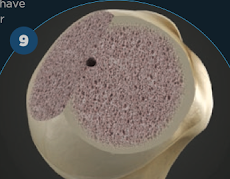These authors, representing some of the senior members of the implant design team, report on the outcomes of a recently introduced anatomic total shoulder arthroplasty with an ellipsoid-shaped articular surface and an all-polyethylene glenoid component
The ellipsoid humeral head is a 1-piece CoCr humerus component with a radius of curvature in the anterior-posterior axis that is 93% of the radius of curvature in the superior-inferior axis.
The humeral component is seated on multiplanar cuts of the humeral head.
The glenoid component is a 1-piece all-polyethylene implant with non-ingrowth angled pegs inserted at 30 degrees anterior to the glenoid articular surface.
The angled pegs were designed to facilitate glenoid component insertion past the greater amount of humeral bone retained in this design (below left) in contrast to the glenoid exposure achieved with a traditional head cut (below right).
Results are reported for 63 shoulders in 57 patients mean age 73. Two thirds of patients had type A glenohumeral pathoanatomy. The amount of retroversion is not described. The preoperative motion for these shoulders was good: average elevation was 121 degrees, ER 28 and IR to L3.
At minimum of 24 months followup forward elevation improved from 121 to 150 degrees, external rotation improved from 28 to 48 degrees, and internal rotation improved from L3 to L1. There were statistically significant improvements exceeding the minimal clinically important difference (MCID) in the American Shoulder and Elbow Surgeons Standardized Shoulder Assessment Form(ASES) score (37 to 94), Single Assessment Numeric Evaluation (SANE) (40 to 93), visual analog scale (6.3 to 0.4), and Patient-Reported Outcomes Measurement Information System physical domain T score (44 to 57).
There were no implant failures or evidence of radiographic loosening of the humerus component in any patients. The authors did not include evaluation of axillary radiographs in this study as the majority were performed at one of several outside community radiology clinics and inconsistency in arm positioning did not allow for reliable grading with this method.
Comment: This report shows good postoperative function for this implant when applied to selected shoulders with a good preoperative range of motion (average 121 degrees) and predominantly type A glenohumeral pathoanatomy. Such shoulder are likely to do better after a total shoulder arthroplasty in comparison to a general population of shoulders that includes a substantial percentage with preoperative stiffness and more complex type B retroverted pathoanatomy. The more functional a shoulder is before arthroplasty the more functional it is likely to be after surgery (see this link). To see a discussion about the potential biasing effect of patient selection, see this post. Assessing the incremental value to the patient of this new technology will require comparison of outcomes in comparable patients in studies that extend to the postoperative time when glenoid components are at risk for failure.
While the curvature of normal humeral heads is not uniformly spherical, the normal head articulates with a glenoid covered with compliant articular cartilage and bordered by a compliant labrum. Whether an ellipsoidal humeral implant articulating in a relatively non-compliant spherical polyethylene glenoid socket will have improved patient outcomes in comparison to the standard total shoulder geometry remains to be demonstrated.
Follow on twitter: https://twitter.com/shoulderarth
Follow on facebook: https://www.facebook.com/frederick.matsen
Follow on LinkedIn: https://www.linkedin.com/in/rick-matsen-88b1a8133/
How you can support research in shoulder surgery Click on this link.
Here are some videos that are of shoulder interest







